Scottish Study of Early Learning and Childcare: Three-year-olds (Phase 3) Report - Updated 2021
Findings from the third phase of the Scottish Study of Early Learning and Childcare (SSELC), a research project established to evaluate the expansion of early learning and childcare in Scotland.
This document is part of a collection
Use of ELC
Formal ELC provision
Funding for the child's ELC provision was covered in both the parent and keyworker questionnaires. The parent questionnaire asked whether all of the child's time at the setting was paid for, whereas the keyworker questionnaire included more detailed questions on the number of registered hours, and whether these were government funded, local authority funded (referred) or self-funded. As with the previous section, the figures for the Eligible 2s are unweighted and the figures for the Comparator 3s are weighted.
Most parents reported that the full costs of the time their child spent at the setting was met by the government, although this proportion was higher for the Eligible 2s (92%, compared with 78% of the Comparator 3s). For the Comparator 3s, clear relationships were evident between whether the child's time at the setting was funded by the government and a range of demographic factors. Nearly all (94%) of respondents in the Comparator 3s group who were not in work or training had full funding through the statutory entitlement, compared with 73% of those who were in work or training. Those on lower incomes were more likely to have all the time spent by the child at the setting funded through their statutory entitlement. This was the case for 92% of those in the bottom income quintile, compared with 83% in the second quintile and 71% of those with higher incomes (see Figure 37). Similar patterns could also be seen by area deprivation (Table C30 in Appendix D). In contrast, there was no clear relationship in the Eligible 2s group between deprivation and funding through the statutory entitlement, and the proportion of those who were in employment and receiving full funding (92%) was almost identical to those who were not in employment (93%).
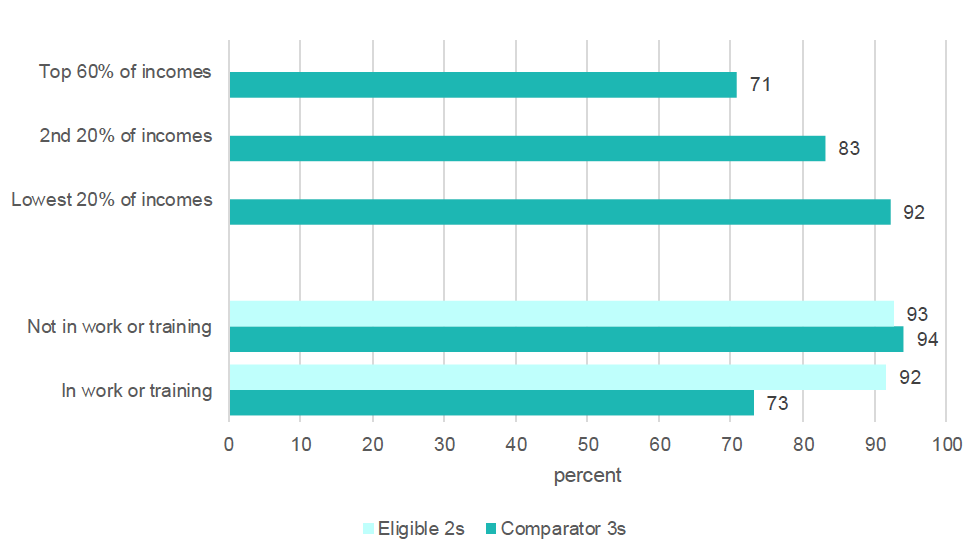
Base: All children (parent questionnaire Phase 3, Eligible 2s unweighted, Comparator 3s weighted)
Figure 37: Proportion of children for whom full costs of time child spends at nursery are met by the government, by equivalised household income (Comparator 3s) and employment status (Eligible 2s and Comparator 3s), Phase 3 Description. This clustered bar chart shows that 94% of respondents in the Comparator 3s group who were not in work or training had full funding through the statutory entitlement, compared with 73% of those who were in work or training. 92% of those in the bottom income quintile had all the time spent by the child at the setting funded through their statutory entitlement, compared with 83% in the second quintile and 71% of those with higher incomes.
The vast majority of parents took their full allocation of statutory funding[31] at one setting: 90% of the Eligible 2s and 82% of the Comparator 3s. The Eligible 2s were registered on average for a higher number of funded hours at the nursery (19.0) than the Comparator 3s (16.7)[32]. When unfunded hours were included, the difference between the groups was much smaller (19.3 hours for the Eligible 2s and 18.3 for the Comparator 3s). Ten percent of the Eligible 2s and 18% of the Comparator 3s were registered for fewer than 15 funded hours per week, while 33% of the Eligible 2s and 26% of the Comparator 3s were registered for more than 16.25 hours[33].
Additional childcare
More of those in the Comparator 3s group than the Eligible 2s got help from a provider other than the nursery they were registered at for the survey. For the former, around half (49%) got help with childcare on a regular basis from another provider compared with a third (32%) of parents/carers of the Eligible 2s. There was no clear relationship across the two groups between household composition and access to additional childcare. Single parents in the Comparator 3s (32%) were less likely to receive help with childcare from another provider than couple parents (52%), but the reverse was the case for the Eligible 2s (single parents - 37%, couple parents - 25%). Those in more deprived areas among the Comparator 3s group were less likely to have accessed additional childcare than those in less deprived areas, while there was no clear linear relationship for the Eligible 2s group (see Figure 38).
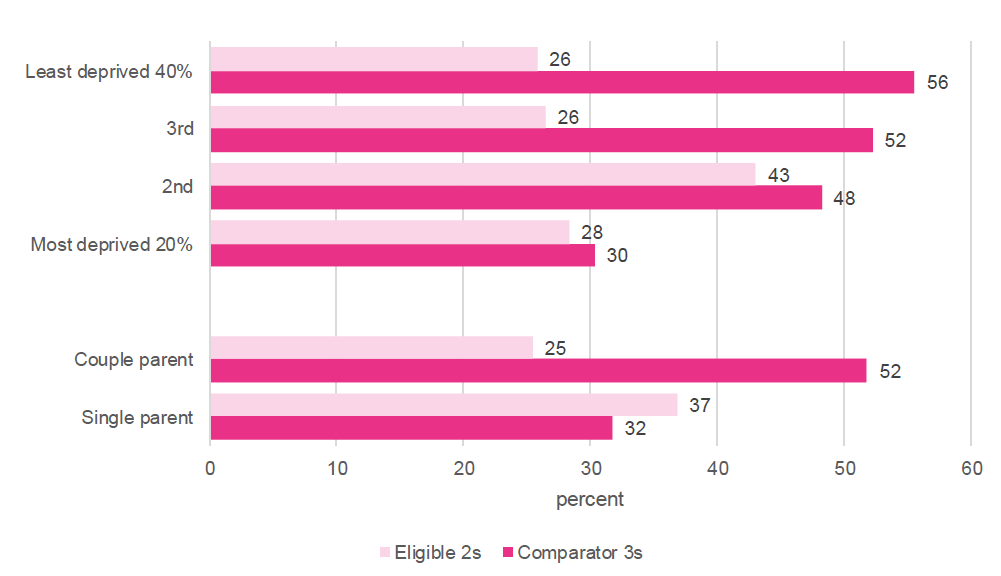
Base: All children (parent questionnaire Phase 3, Eligible 2s unweighted, Comparator 3s weighted)
Figure 38: Whether currently get help with childcare from another provider, by area deprivation and single/couple households, Eligible 2s and Comparator 3s Phase 3 Description. This clustered bar chart shows that 32% of single parents in the Comparator 3s received help with childcare from another provider, compared with 52% of couple parents. For the Eligible 2s 37% of single parents received help with childcare from another provider, compared with 25% of couple parents. 30% of those in the most deprived 20% of areas among the Comparator 3s group had accessed additional childcare, compared with 56% of those in least deprived 40% of areas.
Table 10 lists the other types of childcare used, with some differences evident between the Eligible 2s and Comparator 3s. As mentioned above those in the Eligible 2s group were less likely to have accessed additional childcare than those in the Comparator 3s – three quarters (73%) of the former responded that they had accessed none of the additional types of childcare listed compared with 53% of the Comparator 3s[34]. Those in the Comparator 3s group were also more likely to have used multiple forms of additional childcare: 18% had used two or more compared with 8% of the Eligible 2s.
| Eligible 2s | Comparator 3s | |
|---|---|---|
| % | % | |
| Private or workplace crèche, nursery, playgroup or pre-school | 3 | 7 |
| Local Authority crèche, nursery, playgroup or pre-school | 3 | 5 |
| Community or voluntary crèche, nursery, playgroup or pre-school | 0 | 1 |
| Childminder | 4 | 7 |
| Grandparents | 17 | 36 |
| Ex-spouse | 5 | 3 |
| Another relative | 3 | 3 |
| Nanny or babysitter | - | 2 |
| Friend or neighbour | 1 | 1 |
| Another person | 0 | 1 |
| None of the above | 73 | 53 |
| Unweighted base | 266 | 560 |
Base: All children (parent questionnaire Phase 3, Eligible 2s unweighted, Comparator 3s weighted)
Of the other types of childcare used, grandparents were the most popular, with 36% of parents of the Comparator 3s and 17% of parents of the Eligible 2s having used them. The Comparator 3s were slightly more likely to mention formal types of childcare than the Eligible 2s, although, with the exception of grandparents, the proportions using each type were low for both groups for both formal and informal childcare. Those in work or training were much more likely to use grandparents for childcare than those who were not, and this was the case for both groups. Almost half (46%) of parents of the Comparator 3s in work or training had used grandparents compared with only 8% who were not in work or training, with the equivalent figures being 34% and 6% for the Eligible 2s. Similar patterns could be seen for income, with half (50%) of the Comparator 3s households in the top three income quintiles using grandparents for childcare, compared with 11% in the bottom income quintile (see Figure 39).
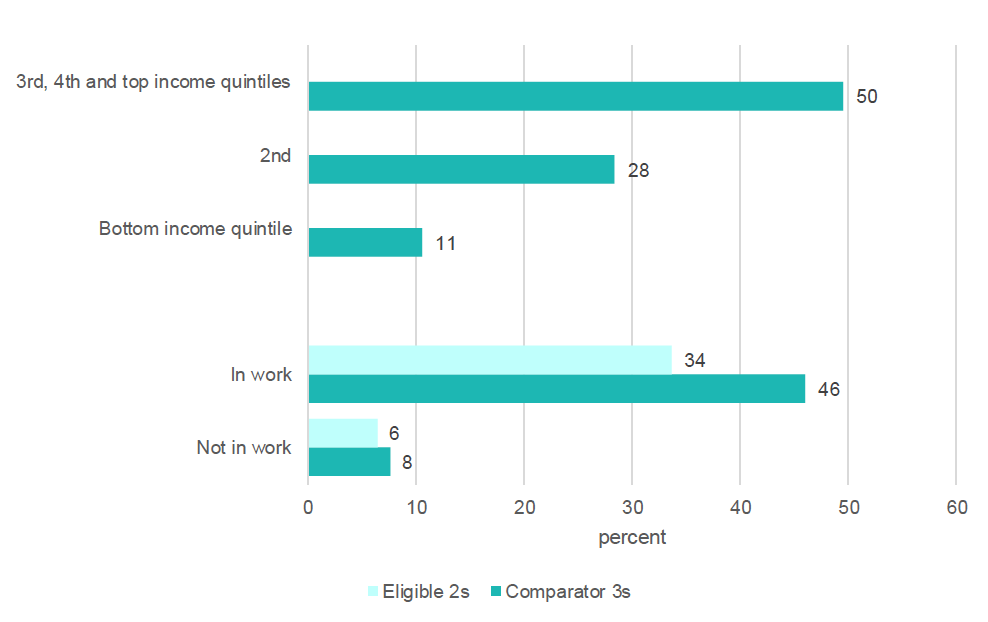
Base: All children (parent questionnaire Phase 3, Eligible 2s unweighted, Comparator 3s weighted)
Figure 39: Whether currently uses grandparents for childcare, by income (Comparator 3s) and employment status (Eligible 2s and Comparator 3s), Phase 3 Description. This clustered bar chart shows that 46% of parents of the Comparator 3s in work or training had used grandparents compared with only 8% who were not in work or training, compared with 34% and 6% of the Eligible 2s. 50% of the Comparator 3s households in the top three income quintiles had used grandparents for childcare, compared with 11% in the bottom income quintile.
The mean number of funded hours outside the nursery was the same for each group – 1.2 hours for both the Eligible 2s and the Comparator 3s. It is in the amount of unfunded additional support that a difference is evident, with those in the Comparator 3s accessing a mean of 7.6 hours of unfunded additional hours per week compared with the Eligible 2s who were accessing a mean of 3.7 hours. Much of this difference can be explained by employment status. In both groups those in work or training accessed, in general, more unfunded hours than those who were not. For the Comparator 3s those in work or training accessed a mean of 9.3 hours of unfunded childcare compared with 2.4 for those who were not in work or training, with the figures for Eligible 2s being 7.9 and 1.0 hours respectively.
Combining data from both the keyworker and parent questionnaires, we can identify different combinations of settings and funding used for childcare[35]. Nearly half (46%) of the Comparator 3s used only the funded ELC at a single setting, while two thirds (66%) of the Eligible 2s did the same. Around a quarter (23%) of the Comparator 3s and 17% of the Eligible 2s used a combination of funded ELC at a single setting and informal childcare. Much smaller proportions used other combinations (see Table 11).
| Eligible 2s | Comparator 3s | |
|---|---|---|
| % | % | |
| Funded formal ELC only - single setting | 68 | 46 |
| Funded formal ELC only - multiple settings | 6 | 2 |
| Funded and unfunded formal ELC - single setting | 3 | 6 |
| Funded formal ELC - single setting + informal | 17 | 23 |
| Funded formal ELC - multiple settings + informal | 5 | 4 |
| Funded and unfunded - single setting + informal | - | 6 |
| Funded and unfunded formal ELC only - multiple settings | 3 | 4 |
| Funded and unfunded formal ELC - multiple settings + informal | 2 | 10 |
| Unweighted base | 120 | 318 |
Base: All children (parent questionnaire and keyworker questionnaire with a definite number of hours provided for different types of childcare, Phase 3, Eligible 2s unweighted, Comparator 3s weighted)
The majority of respondents among both the Eligible 2s (62%) and the Comparator 3s (70%) felt that they got enough support with childcare from family or friends living outside of the household. Those in the Eligible 2s group were slightly more likely than the Comparator 3s to say that they did not get enough support or did not get any support at all (29% compared with 22% of the Comparator 3s), while a small proportion of both groups said that they did not need any support (9% of the Eligible 2s and 8% of the Comparator 3s).
Figure 40 shows that for the Comparator 3s, those in employment were more likely to feel that they had enough support (75%) than those not in employment (54%). They were also less likely to say that they did not need any support (5%) than those not in employment (16%). While the direction of this association cannot be ascertained from the data, it appears that for some parents a lack of support makes it difficult to find suitable employment. For the Eligible 2s the difference between those in work and not in work is much smaller.
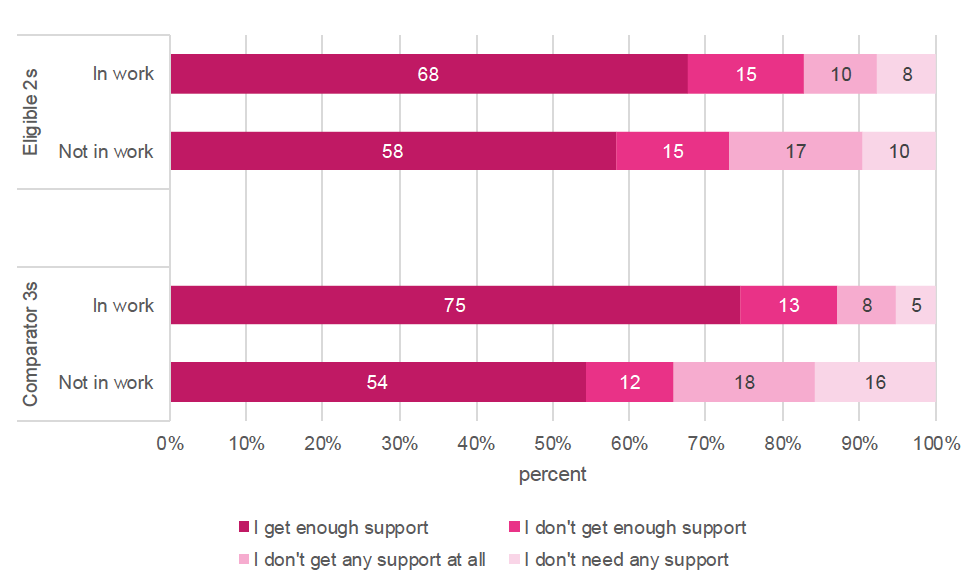
Base: All children (parent questionnaire Phase 3, Eligible 2s unweighted, Comparator 3s weighted)
Figure 40: How respondent feels about the amount of support with childcare they receive, by employment status, Eligible 2s and Comparator 3s, Phase 3 Description. This stacked bar chart shows that for the Comparator 3s, 75% of those in employment felt that they had enough support, compared with 54% of those not in employment. 5% of those in employment felt that they did not need any support, compared with 16% of those not in employment. For the Eligible 2s, 68% of those in employment felt that they had enough support, compared with 58% of those not in employment.
Previous use of childcare
Parents were also asked about what childcare they had used before their child had reached three years old. The responses for both the Eligible 2s and Comparator 3s are summarised in Table 12. While this was intended to include the nursery presently attended, if the child was in attendance before the age of three, it is clear that some parents did not interpret the question in this way. Hence figures for nurseries are an underestimate.
There were some noticeable differences between the types of childcare used prior to the age of three between the two groups. The Eligible 2s were much more likely than the Comparator 3s to have used a local authority run crèche, nursery, playgroup or pre-school (55% compared with 10% of the Comparator 3s), which is not surprising given their eligibility for a funded place at the age of two. On the other hand, the Comparator 3s were more likely to have used a private or workplace crèche, nursery, playgroup or pre-school (35% of the Comparator 3s compared with 17% of the Eligible 2s). The other main difference was in the use of grandparents for childcare: two thirds (64%) of parents in the Comparator 3s group had used grandparents, compared with one third (31%) of parents of the Eligible 2s.
| Eligible 2s | Comparator 3s | |
|---|---|---|
| % | % | |
| Private or workplace crèche, nursery, playgroup or pre-school | 17 | 35 |
| Local Authority crèche, nursery, playgroup or pre-school | 55 | 10 |
| Community or voluntary crèche, nursery, playgroup or pre-school | 3 | 5 |
| Childminder | 8 | 14 |
| Grandparents | 31 | 64 |
| Ex-spouse | 10 | 10 |
| Another relative | 15 | 13 |
| Nanny or babysitter | 2 | 3 |
| Friend or neighbour | 7 | 4 |
| Another person | 5 | 6 |
| Unweighted base | 220 | 507 |
Base: All children (parent questionnaire Phase 3, Eligible 2s unweighted, Comparator 3s weighted)
For both the Eligible 2s and Comparator 3s the use of grandparents prior to the age of 3 was more common in less deprived areas. For the Comparator 3s, 71% of those living in the two least deprived SIMD quintiles had used grandparents compared with 54% in the most deprived; these figures were 42% and 28% respectively for the Eligible 2s. Similar patterns were evident for household income for the Comparator 3s. There was also a clear pattern in terms of household income and area deprivation and the use of private or workplace nurseries prior to the age of three, with their use more common among higher income households for the Comparator 3s and in less deprived areas for both groups (Appendix C Tables C31 and C32).
Engagement with ELC setting
Parents were asked if they had participated in a range of different activities since their child had started nursery. Some of these focused on engagement with the child at the nursery, such as visiting their room or staying and playing with them. Some focused on engagement with the staff, for example discussing their child's progress or offering to help out, while other options included some of the wider support settings can offer such as receiving help with food / clothing or learning a new skill. Responses are summarised in Table 13.
| Eligible 2s | Comparator 3s | |
|---|---|---|
| % | % | |
| Visited your child's room | 94 | 94 |
| Attended a parents' evening or information meeting | 65 | 62 |
| Attended another type of nursery event | 59 | 46 |
| Helped out/offered to help out in the nursery including on a trip | 27 | 21 |
| Stayed and played with your child | 66 | 52 |
| Discussed your child's progress with her/his keyworker | 94 | 88 |
| Talked to someone about how to support your child's learning at home | 57 | 30 |
| Received help with your welfare rights or issues with benefits | 8 | 1 |
| Received help with transport to and from the nursery | 3 | 1 |
| Received help with food or clothing | 11 | 2 |
| Learned a new skill such as cooking or parenting skills | 17 | 2 |
| Unweighted Base | 268 | 563 |
Base: All children (parent questionnaire Phase 3, Eligible 2s unweighted, Comparator 3s weighted)
Almost all parents of the Eligible 2s (>99%) and Comparator 3s (99%) had taken part in at least one of the activities listed since their child had begun nursery. For both groups the most common activities undertaken were visiting their child's room (94% for both groups) and discussing their child's progress with her / his keyworker (94% for the Eligible 2s, 88% for the Comparator 3s). Two thirds (66%) of parents of the Eligible 2s had stayed and played with their child, as had just over half (52%) of parents of the Comparator 3s. Parents of the Eligible 2s were more likely to have spoken to someone about how to support their child's learning at home (57% compared with 30% of the Comparator 3s). Where there are differences between the Comparator 3s and the Eligible 2s in responses to these questions, this is likely to be, at least in part, due to the length of time each group had been attending nursery.
Parents of the Eligible 2s were also more likely to have engaged with some of the wider support some settings are able to provide. For example, 17% of parents in the Eligible 2s group had learned a new skill and 11% had received help with food or clothing, compared with only 2% who had taken part in these activities among the Comparator 3s. Also, 8% of parents of the Eligible 2s had received help with welfare rights or benefits, compared with only 1% of parents in the Comparator 3s.
Accessibility, advantages and disadvantages of child being in nursery
Table 14 shows that a majority of parents lived within 10 minutes of the nursery: 71% of the Eligible 2s and 81% of the Comparator 3s. Only 2% of the Eligible 2s and 1% of the Comparator 3s lived more than half an hour from the nursery they attended.
| Eligible 2s | Comparator 3s | |
|---|---|---|
| % | % | |
| 0 to 5 minutes | 43 | 51 |
| 6 to 10 minutes | 29 | 29 |
| 11 to 15 minutes | 13 | 11 |
| 16 to 20 minutes | 8 | 6 |
| 21 to 30 minutes | 5 | 2 |
| More than 30 minutes | 2 | 1 |
| Unweighted base | 263 | 552 |
Base: All children (parent questionnaire Phase 3, Eligible 2s unweighted, Comparator 3s weighted)
Parents were asked what the main advantages and disadvantages were of their child attending nursery. Advantages for the parent – such as enabling them to work, study or train, care for others or to do other things – were included as well as advantages for the child such as improving their confidence, giving them an opportunity to socialise and helping their educational development. A summary of responses for both the Eligible 2s and Comparator 3s is given in Figure 41.
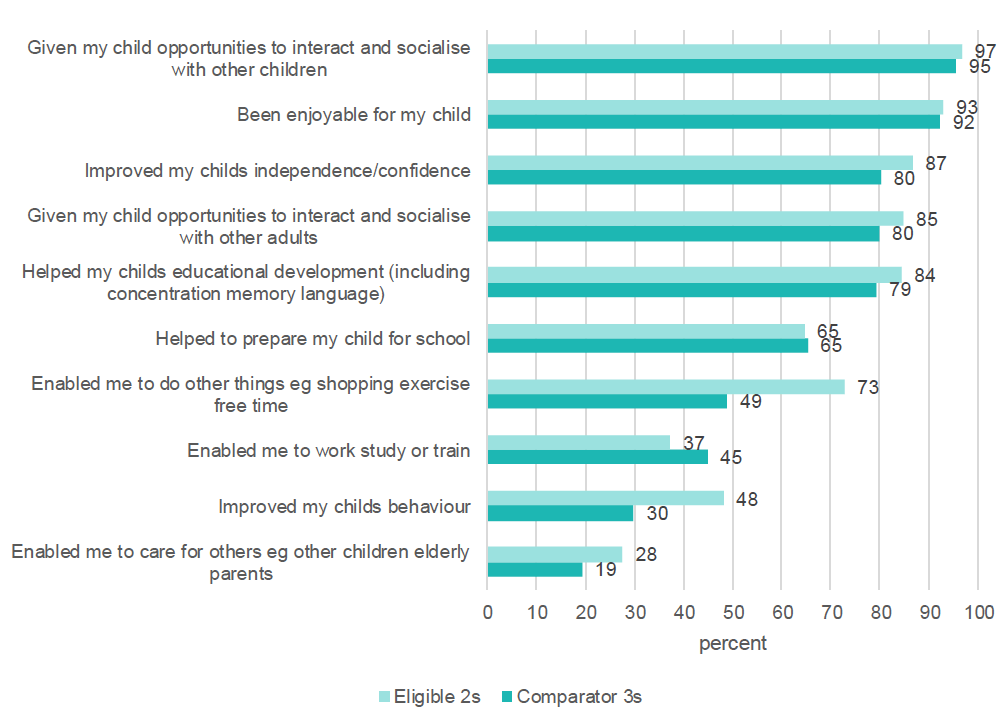
Base: All children (parent questionnaire Phase 3, Eligible 2s unweighted, Comparator 3s weighted)
Figure 41: Main advantages of child being in nursery Description. Parents were asked what the main advantages were of their child attending nursery from a list of 10 options. This bar chart shows the proportion of parents who selected each response for Eligible 2s and Comparator 3s.
As can be seen responses were broadly similar across the Eligible 2s and Comparator 3s. The most popular responses were to do with advantages for the child, with more than 9 in 10 in each group saying that attending nursery had been enjoyable for their child and that it had given their child opportunities to interact and socialise with other children. A slightly higher proportion of the Comparator 3s than the Eligible 2s mentioned that it had enabled them to work, study or train (45% and 37% respectively), while the reverse was true in terms of enabling them to care for others (28% of Eligible 2s and 19% of Comparator 3s). Those in the Eligible 2s group were more likely to cite as a main advantage that it had enabled them to do things other than work, study or care (73%) than those in the Comparator 3s group (49%). They were also more likely to say that it had improved their child's behaviour (48% compared with 30% for the Comparator 3s).
A majority of parents in both groups said there were no disadvantages to their child being in nursery – 67% of the Comparator 3s and 70% of the Eligible 2s. Where disadvantages were cited the more popular responses were that the child was not in nursery for long enough to enable time for work (15% of Comparator 3s and 14% of Eligible 2s), that nursery hours were not flexible (13% of Comparator 3s and 9% of Eligible 2s), and that the child picks up bad behaviour (9% of Comparator 3s and 11% of Eligible 2s). Other reasons were rarely cited by parents in either group (see Figure 42).
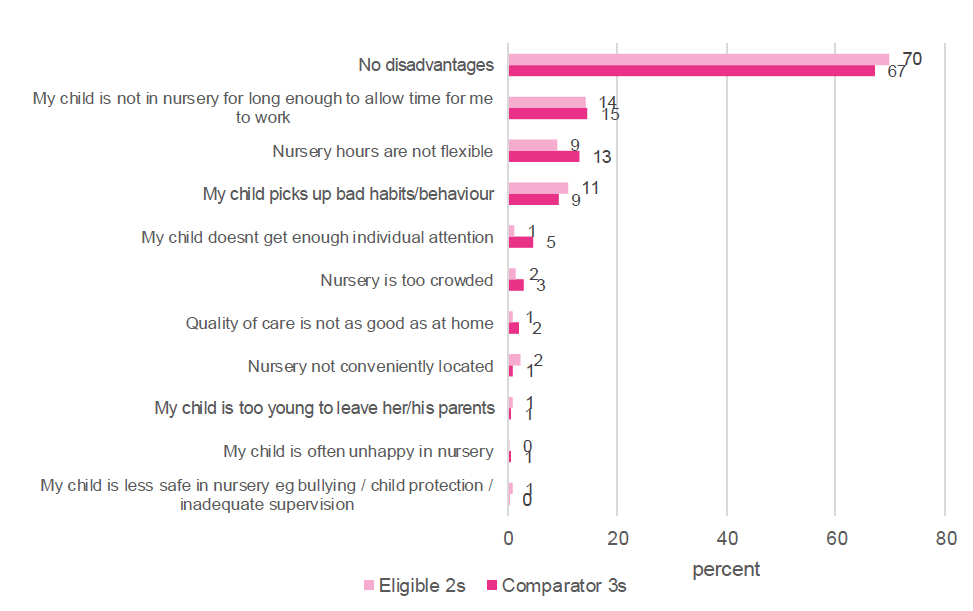
Base: All children (parent questionnaire Phase 3, Eligible 2s unweighted, Comparator 3s weighted)
Figure 42: Main disadvantages of child being in nursery Description. Parents were asked what the main disadvantages were of their child attending nursery from a list of 11 options. This bar chart shows the proportion of parents who selected each response for Eligible 2s and Comparator 3s.
Contact
Email: socialresearch@gov.scot
There is a problem
Thanks for your feedback